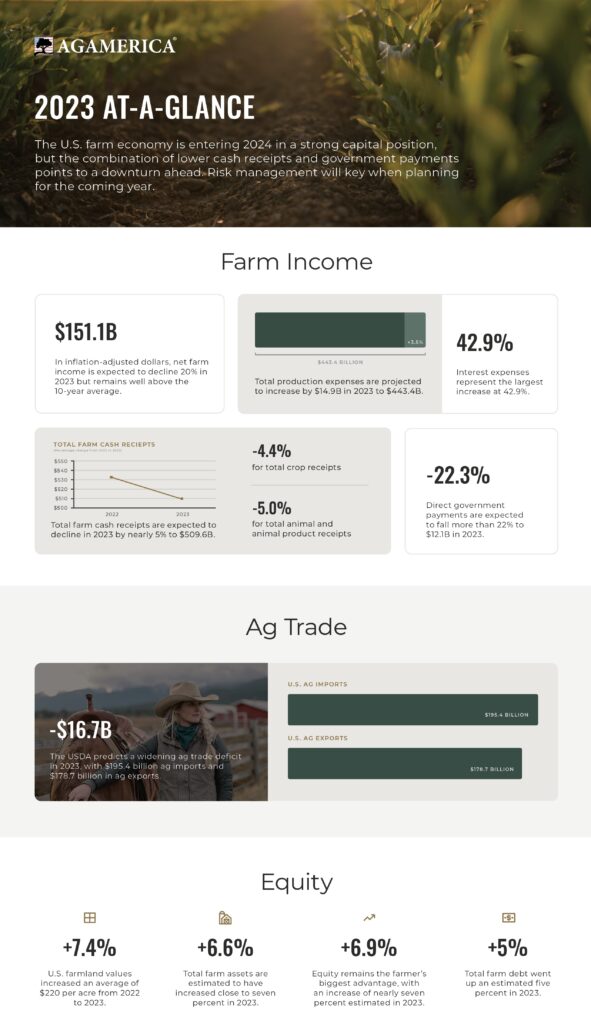Year in Review: The 2023 U.S. Farm Economy
The U.S. farm economy faced many ups and downs in 2023, but nevertheless ended the year strong.
After record-breaking farm income in 2022, factors that propelled key commodity prices and government payments forward reversed course, indicating a potential slowdown ahead for the U.S. farm economy. Even so, net farm income ended the year 7.2 percent higher than two years ago and 49 percent above the 10-year average.

Although the U.S. farm economy is starting the year strong, risk management to protect operational liquidity will be crucial for landowners in 2024.
Five Events in 2023 That Will Shape the 2024 Farm Economy
Here are five things that took place in 2023 that could impact farmers in 2024.
1. The U.S. dodged a recession.
The odds of a recession happening outweighed the odds of avoiding one at the beginning of 2023. Instead, the market defied expectations—U.S. GDP exceeded even pre-pandemic estimates, growing as much as five percent in the third quarter due to aggressive rate hikes, steady consumer spending, and a strong job market.
Despite this turnaround, consumer sentiment remains poor. Almost two-thirds of Americans believe the economy is getting worse. Consumer sentiment isn’t matching up with the actual performance of the economy.
What this means for rural landowners: For rural landowners, a slowdown is expected in cash receipts, land values, and government payments. Landowners should invest in cost-saving strategies to be proactive in managing risk and protecting liquidity.
2. Banking blunders changed the way many farmers finance.
The banking crisis hit the press with a bang after three high-profile banks failed back-to-back. In an effort to protect consumers, the federal government cracked down on banking regulations. This led to tightening restrictions on financial institutions, and a substantial amount of money being injected into the economy.
What this means for rural landowners: The dynamics between alternative private credit and public fixed income is evolving. “Debanking” will increase options for farmers seeking loans as the private credit sector continues to expand.
3. The ag sector escaped the brunt of federal rate hikes.
Since March 2022, the Fed hiked rates 11 times before finally pausing on December 19. All these hikes were a response to inflation—and it seems to be working. The Consumer Price Index (CPI) for all items indicates a year-over-year inflation rate of 3.1 percent, just one percent above the federal target of two percent.
What this means for rural landowners: The worst of rate hikes is likely over, and economists expect cuts to start happening by mid-2024. Even so, those in variable rate loan structures will need to account for the worst case scenario when reviewing their balance sheets to ensure loan obligations will continue to be met.
4. The farm bill didn’t pass on time.
After much debate over a $20 billion conservation plan and the large Supplemental Nutrition Assistance Program (SNAP) budget, Congress failed to pass the farm bill before it expired. This has left many farmers frustrated, as they wait to see how critical federal programs will change.
“Congress did manage to pass a continuing resolution to keep the government open, so some programs dependent on annual funding can keep working for now, but the extension on funding likely means even more debate over government spending to come and a further delay.” – Bradley Lubben, University of Nebraska-Lincoln extension policy specialist
What this means for rural landowners: Congress failed to pass the farm bill before the end of 2023, resulting in a year-long extension. This delay may cut funding for some government programs and put others on hold as we enter an election year that could be even more volatile.
5. International conflict could impact global trade.
The Ukraine-Russia conflict continued through 2023, and the end of the Black Sea Deal put more pressure on an already strained European economy. It also resulted in increased shipping expenses for farmers selling abroad.
The Israel-Palestine conflict is predicted to potentially impact international trade agreements, but it remains unclear if and how it could affect farmers on U.S. soil.
The United States and Canada are expected to meet with Mexico over their recent policy to ban GMO corn. Resolution is expected sometime in the summer of 2024, with the U.S. hoping to retract the proposed policy.
What this means for rural landowners: Sales and profit margins may be affected as trade and foreign policy changes. It’s important to keep an eye on global trade as the year continues and diversify buyers as much as possible.
Step Towards Financial Success in the 2024 Farm Economy
As an agricultural lender, AgAmerica stays on the cusp of any economic developments that impact farmers. Our goal is to help our clients grow by keeping them informed and financially flexible, ready to pivot as the economy changes.
Download the 2024 Farm Economy Outlook today to unlock insights to help you prepare for 2024.






